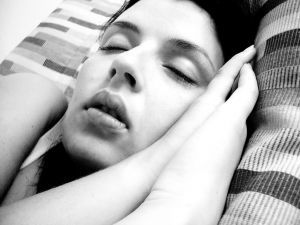Somewhere in the neighborhood of 1am I recall being awakened by the sound of plastic being rustled in my kitchen garbage can. The rustling was very distinct, and I remember feeling terribly frightened. It was obvious to me that someone had broken into my loft apartment, and was at that moment, taking a tour of my kitchen. As the fear continued to mount, I struggled to get out of bed in an attempt to reach my cordless phone. It was at that exact moment that I realized I could not move. Lying on my back in the darkness, I remember straining against something unseen that kept me from lifting my arms, or rising from bed. The rustling continued for what seemed like several minutes, until somehow I commanded my brain to allow my limbs to move. Upon moving, my eyes suddenly snapped open, and the crinkling of plastic ceased. I was awake. I chalked this experience up to a disturbing dream until it happened again.
This time I was once again asleep when I heard what sounded like footsteps padding up the stairs to my bedroom. Oddly, the footsteps didn’t sound human, more like a dog with a limp. Either way, I was not looking forward to encountering the source of the sound. Again, I attempted movement, and was met with nothing but immobility. My heart began to race, as I “looked” around the room for either the cordless phone, or something with which to protect myself. For several seconds, my efforts were in vain. I could not budge. As soon as I found the will to move, my eyes snapped open and I found myself safely in my bed. There was nothing and no one in my apartment besides myself. These occurrences were terrifying. And though each episode felt more like a nightmare than anything else, I knew that there was some deeper explanation. My research led me to the discovery of the phenomenon of Sleep Paralysis.
What is Sleep Paralysis?
According to doctors, there are two different form of sleep paralysis: hypnagogic and hypnopompic. Hypnagogic paralysis occurs shortly before falling asleep, while hypnopompic paralysis typically occurs right after falling asleep. This condition usually happens when the brain is awakened from REM sleep. This state is often marked by visual or auditory hallucinations, or the sensation of being “crushed” or held down. From a medical perspective, this state arises in order to protect the sleeper from “acting out” his/ her dreams. The condition can last anywhere from a few seconds to several minutes. Oftentimes, the seconds can feel like minutes while the paralysis is taking place. The medical community has also linked this phenomenon with those who suffer narcolepsy. Furthermore, there are few causes that have been associated with the occurrence of sleep paralysis. Sleeping in the supine position (that is, on one’s back), lucid dreaming, sleeping aids, stress, and even irregular sleeping schedules are thought to contribute to these frightening episodes.
Other Theories about Sleep Paralysis…
There are many theories surrounding this phenomenon, including the Succubus/Incubus myth, in which a demon-like creature sits upon the chests of sleeping men and women. This theory derived from medieval lore, proclaims that a demon or goblin is actually responsible for the paralyzing sensation. Similar theories exist in the folklore of India, Japan, Mexico, and even Greece. Another hypothesis centers on the belief in Out-of-Body Experiences, or OBE’s.
Many communities insist that it is very possible to separate the body from the spirit (or the mind). This state can be induced by a method called astral projection. Or it can occur more naturally, as one drifts into REM sleep from consciousness. People who claim to have traveled into other realms of existence usually mention the feeling of being immobilized. Others have claimed to hear or “feel” a buzzing sensation all throughout their bodies. Almost all of them declare that some sort of sleep paralysis occurs. If one were to believe that astral projection is possible, then the concept of sleep paralysis can be very easily explained:
During the separation of spirit from body, the physical body goes to sleep. However, because REM sleep has not yet occurred in the brain, the spirit (mind) remains somewhat active. It is during this time that hallucinations, visual or otherwise are most prevalent. Those who consider sleep paralysis to be a condition of OBE’s believe that the visual and audible experiences are not hallucinations at all-but manifestations of the spirit world. That is why people are able to “see” their surroundings during these odd, yet horrifying encounters. In addition, it is believed that the bodily “jerks” which typically accompany the drifting into sleep, are nothing more than the spirit reconnecting with the body. According to theorists, this is why one seems to “snap” awake after just a few seconds of sleep.
So What’s the Real Truth?
Clearly, the latter explanation as to the origin of sleep paralysis seems a little far-fetched to most. Medical rationalizations make complete sense, as it is entirely plausible that our bodies possess internal mechanisms to protect us from harm during sleep. But those who believe in deeper aspects of the psyche are quick to rebuff medical validation.
Perhaps it should be said that both theories can exist in tandem. While the medical community has explained what happens to our bodies during the mysterious process of sleep, that same community has yet to nullify or confirm what happens in the spirit world.
